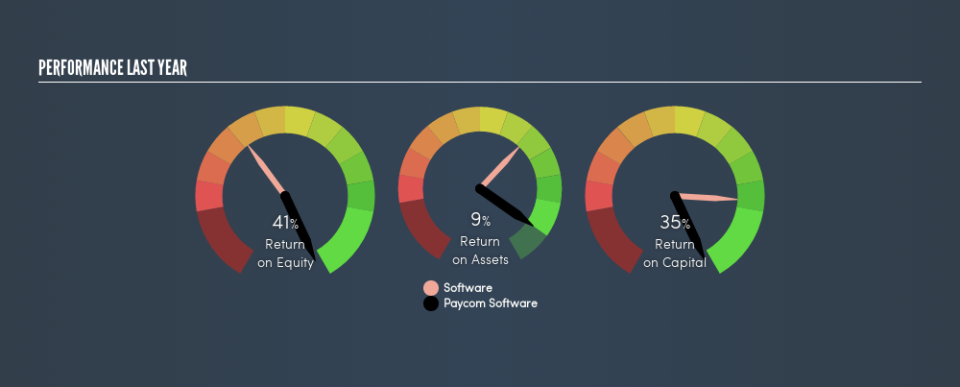Paycom Software, Inc. (NYSE:PAYC) Earns Among The Best Returns In Its Industry

Want to participate in a research study? Help shape the future of investing tools and earn a $60 gift card!
Today we are going to look at Paycom Software, Inc. (NYSE:PAYC) to see whether it might be an attractive investment prospect. In particular, we'll consider its Return On Capital Employed (ROCE), as that can give us insight into how profitably the company is able to employ capital in its business.
First up, we'll look at what ROCE is and how we calculate it. Second, we'll look at its ROCE compared to similar companies. Last but not least, we'll look at what impact its current liabilities have on its ROCE.
Return On Capital Employed (ROCE): What is it?
ROCE measures the 'return' (pre-tax profit) a company generates from capital employed in its business. All else being equal, a better business will have a higher ROCE. In brief, it is a useful tool, but it is not without drawbacks. Author Edwin Whiting says to be careful when comparing the ROCE of different businesses, since 'No two businesses are exactly alike.'
So, How Do We Calculate ROCE?
Analysts use this formula to calculate return on capital employed:
Return on Capital Employed = Earnings Before Interest and Tax (EBIT) ÷ (Total Assets - Current Liabilities)
Or for Paycom Software:
0.35 = US$174m ÷ (US$1.5b - US$1.0b) (Based on the trailing twelve months to December 2018.)
Therefore, Paycom Software has an ROCE of 35%.
Check out our latest analysis for Paycom Software
Is Paycom Software's ROCE Good?
When making comparisons between similar businesses, investors may find ROCE useful. Using our data, we find that Paycom Software's ROCE is meaningfully better than the 9.1% average in the Software industry. We consider this a positive sign, because it suggests it uses capital more efficiently than similar companies. Putting aside its position relative to its industry for now, in absolute terms, Paycom Software's ROCE is currently very good.
In our analysis, Paycom Software's ROCE appears to be 35%, compared to 3 years ago, when its ROCE was 23%. This makes us think the business might be improving.
When considering this metric, keep in mind that it is backwards looking, and not necessarily predictive. Companies in cyclical industries can be difficult to understand using ROCE, as returns typically look high during boom times, and low during busts. ROCE is only a point-in-time measure. Since the future is so important for investors, you should check out our free report on analyst forecasts for Paycom Software.
How Paycom Software's Current Liabilities Impact Its ROCE
Short term (or current) liabilities, are things like supplier invoices, overdrafts, or tax bills that need to be paid within 12 months. Due to the way the ROCE equation works, having large bills due in the near term can make it look as though a company has less capital employed, and thus a higher ROCE than usual. To check the impact of this, we calculate if a company has high current liabilities relative to its total assets.
Paycom Software has total assets of US$1.5b and current liabilities of US$1.0b. As a result, its current liabilities are equal to approximately 68% of its total assets. Paycom Software's high level of current liabilities boost the ROCE - but its ROCE is still impressive.
The Bottom Line On Paycom Software's ROCE
In my book, this business could be worthy of further research. You might be able to find a better buy than Paycom Software. If you want a selection of possible winners, check out this free list of interesting companies that trade on a P/E below 20 (but have proven they can grow earnings).
I will like Paycom Software better if I see some big insider buys. While we wait, check out this free list of growing companies with considerable, recent, insider buying.
We aim to bring you long-term focused research analysis driven by fundamental data. Note that our analysis may not factor in the latest price-sensitive company announcements or qualitative material.
If you spot an error that warrants correction, please contact the editor at editorial-team@simplywallst.com. This article by Simply Wall St is general in nature. It does not constitute a recommendation to buy or sell any stock, and does not take account of your objectives, or your financial situation. Simply Wall St has no position in the stocks mentioned. Thank you for reading.

